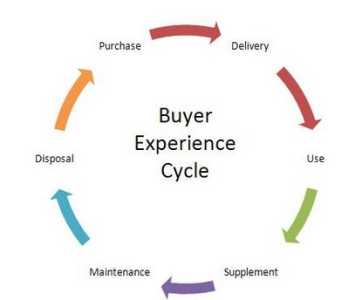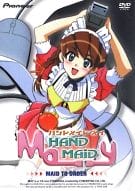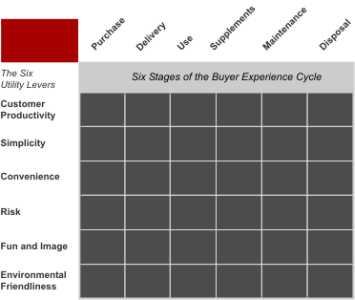 Through this discussion of Blue Ocean strategy, we’ve taken a look at the business landscape primarily through the eyes of the entrepreneur, the person actually creating the product. However, to get a good, full grasp on the landscape requires the occasional reversal of perspective. Tonight, we’ll be taking a more detailed look at the customer’s point of view, as we discuss the core components of the buying experience, as well as the concepts of customer utility.
Through this discussion of Blue Ocean strategy, we’ve taken a look at the business landscape primarily through the eyes of the entrepreneur, the person actually creating the product. However, to get a good, full grasp on the landscape requires the occasional reversal of perspective. Tonight, we’ll be taking a more detailed look at the customer’s point of view, as we discuss the core components of the buying experience, as well as the concepts of customer utility.
As most people know, customers enjoy getting excited over certain products. They will go to great lengths to ensure that the excitement remains. They’ll glean every miniscule scrap of information, listen to countless interviews and puff pieces, and sometimes even camp out for the items that they desire. After all – their new object of affection is different! It’s unique! The experience of bringing it through the checkout will change every fiber of their very lives!
…Except it won’t.
The actual buying experience, hype and excitement aside, can actually be broken down into six core concepts:
- Purchase
- Delivery
- Use
- Supplement
- Maintenance
- Disposal
Each of these concepts flows into the next in the list, until Disposal finally gives way to a new Purchase. The entire process is referred to as the Buyer Experience Cycle in Blue Ocean terminology, and serves as the launching point for all sales observations.
The cycle begins with the Purchase step. In this phase, key questions of how to get customers interested and buying a product should be addressed. This includes the following:
- Can customers find the product easily?
- Is the product displayed in an attractive manner?
- Is the check-out process secure?
- How long does it take to get the product?
One can look at the DVD release of Abunai Sisters. For those that remember, Pony Canyon made a big deal about the title at Otakon 2008, as a major project between the company and Production I.G. It was going to be special, it was going to be available in the US at the same time as it was in Japan! However, at the same time, the title was exclusive to pre-orders, The initial price was set at an astronomical level (the initial price was 34,000 yen, or $438.20 US) which would drop slowly as more pre-ordered. To make matters worse, the show could only be bought through one website. The site itself was poorly designed, with text that appeared to be written by someone with a minimal grasp of the English language.
With this in mind, it’s easy to see that many of the core concerns in the Purchase phase were not only missed, but outright ignored as the company tried to cash in on a product with unsure prospects.
The Purchase phase gives way to Delivery, which deals with getting the product into the new customer’s hands. Questions that rest in this phase include the following:
- How long does it take to get the product to customers?
- Does the product need to be assembled? If so, is it easy to assemble?
- How does the product get to customers?
This is the age-old argument of “catalog vs. in-store,” Ikea vs. Jordan’s. With most products, trade-offs must be made. Online businesses lack the instant gratification of brick and mortar stores, and must revise their other strategies. Likewise, Ikea, which offers a product that doesn’t always need delivery, has advantages and disadvantages over a traditional furniture store that offers fully-assembled furniture items that require delivery.
The Use phase is, without a doubt the most most important of the phases, as it deals with how customers react to the product once it’s in their homes. The user experience, from learning to storage is tested on a daily basis. These are the features that customers will talk most about, and their reactions will influence other potential buyers’ decisions. Questions commonly asked to address this phase include:
- Does a user need to be taught to use the product?
- How does the product perform its function?
- Does the product overshoot the market?
Overshooting the market is a cardinal sin of product development. This is a phenomenon that occurs when the cost is driven up by going too far in technological advances, or by making the product overly complicated with extra features. By creating these barriers, one can (and often will) alienate the very people he’s trying to reach.
 There aren’t many examples of a product overshooting the market in the anime world, though there are a number of products that fail other key Use step requirements. For example, the 2001 release of Hand Maid May opened to a menu screen labeled “Nanbara’s Room.” On the screen were no fewer than twelve choices, none of which said “Play DVD.” Instead, the audio instructs viewers to choose the “correct” option with no indicator of which this will be. Choosing the “wrong” option pushed viewers to a 40-second video clip of the show’s Nanbara character doing something stupid before kicking the user back to the menu. The correction option would finally push users to the DVD menu proper. It was cute… for the first time. However, future viewings saw this feature quickly become a nuisance, as it put a brick wall between the user and their ability to use the DVD. The barrier was small in comparison to numerous other potential problems, but it certainly did do plenty to hinder the product’s overall usability.
There aren’t many examples of a product overshooting the market in the anime world, though there are a number of products that fail other key Use step requirements. For example, the 2001 release of Hand Maid May opened to a menu screen labeled “Nanbara’s Room.” On the screen were no fewer than twelve choices, none of which said “Play DVD.” Instead, the audio instructs viewers to choose the “correct” option with no indicator of which this will be. Choosing the “wrong” option pushed viewers to a 40-second video clip of the show’s Nanbara character doing something stupid before kicking the user back to the menu. The correction option would finally push users to the DVD menu proper. It was cute… for the first time. However, future viewings saw this feature quickly become a nuisance, as it put a brick wall between the user and their ability to use the DVD. The barrier was small in comparison to numerous other potential problems, but it certainly did do plenty to hinder the product’s overall usability.
 The Supplement phase focuses on potential supplementary additions to a product. Basically, whatever companion materials, add-ons, or extra services may be applied to a product post-purchase are accounted for in this segment. Questions of pricing, ease of installation or use, and ease of acquisition are all addressed in this segment. In the anime world, supplementary products include items like art books and companion video games. For example, Bandai’s .hack franchise began as a series of PlayStation 2 games, but used anime OVAs as supplements to expand upon the game experience, as well as a television show that aired roughly along-side the games’ releases. .hack//SIGN and .hack//LIMINALITY built upon the game, and served to reinforce the core product.
The Supplement phase focuses on potential supplementary additions to a product. Basically, whatever companion materials, add-ons, or extra services may be applied to a product post-purchase are accounted for in this segment. Questions of pricing, ease of installation or use, and ease of acquisition are all addressed in this segment. In the anime world, supplementary products include items like art books and companion video games. For example, Bandai’s .hack franchise began as a series of PlayStation 2 games, but used anime OVAs as supplements to expand upon the game experience, as well as a television show that aired roughly along-side the games’ releases. .hack//SIGN and .hack//LIMINALITY built upon the game, and served to reinforce the core product.
In the Maintenance step, questions about how to keep and maintain the product are answered. The following key questions arise in this step:
- Does the product need regular maintenance?
- How easy is it to maintain?
- How easily can a user upgrade or fix the product?
- Is maintenance expensive?
The final phase, Disposal phase serves as the final step in the Buyer Experience Cycle, and deals with the problems involved when a customer decides to finally pu their once-beloved product to the curb. Questions of what waste it produces, how easy it is to dispose of the product, and dispoal price are all addressed in this step, which completes the loop from Purchase to Disposal.

Utility Levers are methods in which a product seller can bypass one or more of the stages of the Buyer Experience Cycle. Many of these are self-explanatory measures, which enhance the overall experience for the buyer. Simplifying a product’s interface, or cutting extraneous features will enhance the use step, while reducing a product’s need for potentially hazardous chemicals like mercury, cadmium, or lead will enhance the disposal step. The six most common Utility Levers are as follows:
- Productivity
- Simplicity
- Customer Risk
- Fun & Image
- Environmental Friendliness
- Convenience
With the proper approach toward a new product or technology, a business can remove the boundaries that exist in the current market, and unlock an entirely new ocean of possibilities. Which levers they choose to pull though, is what will truly shape the final product.









